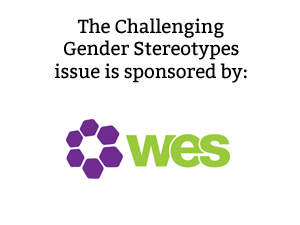Tessa Trabue joined the Let Toys Be Toys campaign in 2013 after she became frustrated by the proliferation of gendered products, packaging and promotions for toys and children’s books that restricted her young son’s choices. Let Toys Be Toys grew out of a Mumsnet discussion thread in late 2012; within weeks a group had been formed that began researching and surveying retailers to assess the extent of the problem. Today the group has a strong media profile and has convinced 14 major UK retailers and 10 book publishers to drop the ‘boys’ and ‘girls’ signage from the toy aisles and book covers, and has also developed a Toymark good practice award.

“…Childhood is a time to explore imagination, follow interests and develop new skills. These heavily marketed and arbitrary divisions in the toy and book markets can be harmful to children by telling them that a whole range of potential interests are off limits to them…”
Getting involved with the Let Toys Be Toys campaign
As a person who experienced childhood in the colourful 1970s, a time when both boys and girls were encouraged to play with a range of toys ranging from dolls to cars to Lego, I hadn’t noticed how segregated the children’s toy, book and clothing market had become until I had my own child in 2006, and was largely faced with a sea of pink and blue in most of the main retail shops.
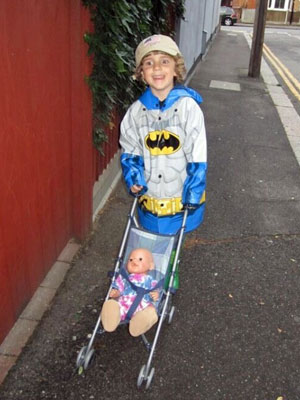
I ignored the signs myself, and chose to buy my child a range of colourful clothing and toys of all different types, including trains, dolls, cars and a baby buggy. However, it was actually through labelled books that I realised the future limits this might have on my child once he was able to read.
One of the first chapter books I read to my son was Alice in Wonderland, and I can still remember the look of rapt enjoyment on his face when he would listen to the story. Around that time, I visited a bookstore and saw that book, along with The Secret Garden, Pippi Longstocking and A Little Princess, packaged up with a big label saying “Books for Girls” and a similar package containing Kidnapped, Treasure Island and other books with a label saying “Books for Boys”.
My son was just starting to read, and had recently told me he couldn’t buy a magazine he wanted in a shop as it was under a sign saying it was for girls. It suddenly dawned on me that, although adults may choose to ignore the signs, children often see these signs as rules, and these labels could have a major impact on what my son felt free to read, play with and explore. Soon after this, I was very pleased to come across the Let Toys Be Toys campaign, which had only formed a few months before, and contacted them to see if I could help out.
The acceleration of the gendering of toys in the past two decades
According to research by Dr. Elizabeth Sweet, a sociologist whose research focuses on gender and children’s toys, the marketing of toys today is more gendered than at any time in past 50 years. Dr. Sweet found that gender-coded toy advertisements were at their lowest number during the 1970s and early 1980s; for example, in a Sears toy catalogue during this period, less than 2% of toys were labelled as for boys or for girls, and she also found many ads actively challenged gender stereotypes.
However, in the mid-1980s and 1990s, there was a marked increase in gendered toys. Pinkification went hand in hand with the rise of the princess culture. Manufacturers also started making the same toy in pink and blue versions, presumably to convince parents with both boy and girl children that they need to shell out for two different versions of the same toy.
Not just about colours
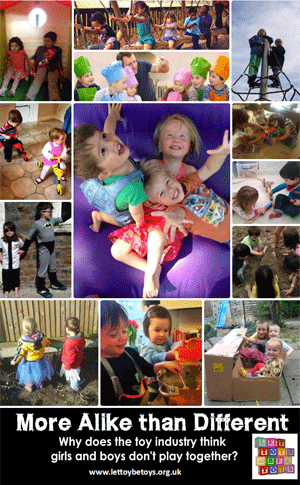
This divide in toys is not just about colours, however. Time and time again, we find that the toys and books labelled for girls contain themes of beauty, caring and domestic work, while the toys and books labelled for boys regularly have themes of action and adventure, transport, and science, and lack caring themes.
Childhood is a time to explore imagination, follow interests and develop new skills. These heavily marketed and arbitrary divisions in the toy and book markets can be harmful to children by telling them that a whole range of potential interests are off limits to them, discouraging them from discovering new skills or considering certain careers in the future.
A national campaign run entirely by volunteers
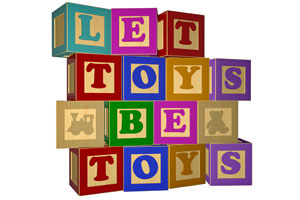
The Let Toys Be Toys campaign is made up entirely of unpaid volunteers, and we fit our campaigning around paid work, family and other commitments. There are less than ten regular active members who work across most areas of the campaign, like myself, and then a handful of other volunteers who focus on specific projects, such as developing lesson plans for schools, or working on identifying, assessing and awarding our good practice Toymark retailers.
Volunteers do come and go from the campaign based on their personal needs and commitments – at this point in time, only three of the original founding members are active members in the group. The group has a very flat structure and there are no managers or hierarchy, and it is a very successful model of true collective working.
We are a social media campaign, mainly using Twitter but also with a good Facebook presence, and we also ‘meet’ and organise on private social media pages. Volunteers are based throughout the UK and Ireland, and it was a few months into the campaign before any of the volunteers had met another one in person; we still have several volunteers who have never met another one in real life.
Online campaigning means that people can participate and contribute when they get a chance, be that during a lunch break at work or after the kids’ bedtime routine, which enables people who traditionally might find it challenging to physically attend meetings, such as parents, to get involved.
Balancing campaigning with my day job
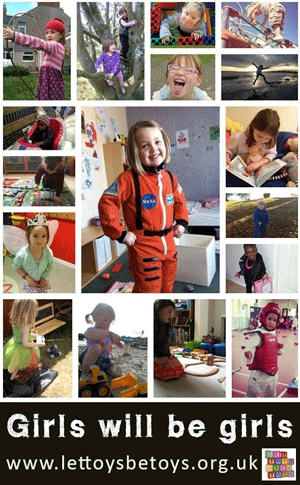
I currently work in a busy role as an executive assistant at a large London university, and also have childcare responsibilities. I fit my campaigning into all of the small gaps I have throughout the day: my short train journey into work; coffee and lunch breaks; waiting time when my child is at a lesson; and then after his bedtime.
I am as enthusiastic about the campaign now as the day I joined; it feels like there is never enough time to do all we want, the work is really a labour of love and I look forward throughout the day to catching up with the latest ideas, conversations and ongoing tasks being posted on the board.
Reaction from retailers and publishers
We have been really pleased with the response from retailers and publishers to our campaign. To date, 14 major UK retailers have agreed to take down the gendered signs in the toy aisles, and let children have the freedom to choose what to play with.
Our requests to the retailers and their responses came mainly from retweeting images of signs in the various stores along with comments from our supporters, although we did support these asks with more formal request letters to the shops as well as a petition.
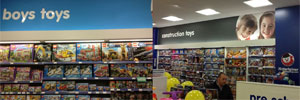
Our in-person meetings with retailers, The Entertainer and Toys R Us, were both very successful and major wins for the campaigns. Some retailers have done a better job with their new signs than others; we were particularly pleased with the useful toy categories and photos showing both a boy and girl in The Entertainer’s updated signs. We still have get to hear back from some retailers for our request to discuss the issue further.
On World Book Day in 2014, in partnership with inclusive children’s booksellers, Letterbox Library, we launched our Let Books Be Books campaign with a petition asking children’s book publishers to please stop labelling books as just for boys or just for girls. The campaign received a lot of media attention and two publishers, Usborne and Parragon, agreed almost immediately to remove the labels. This has been followed by other major publishers such as Scholastic, Penguin Random House, and most recently, Buster Books agreeing not to publish the gendered titles anymore.
We have been really pleased also to gain cross party support from several MPs and statements of support from several prominent authors including Malorie Blackman, Anne Fine and S.F. Said.
Resources for schools
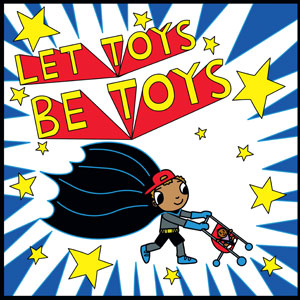
In the past couple of years we have worked with teachers and other educational professionals, such as Mark Jennett, to develop a set of resources for schools to use to help challenge gender stereotypes.
These resources include lesson plans ranging from Reception to Key Stage 3 that teachers can use to foster learning and discussion around gendered marketing, and handy tips that teachers can use in the classroom to ensure that they are not reinforcing gender stereotypes, such as not asking for “strong boys” to move furniture or dividing up children by gender, which reinforces the idea that being a boy or a girl is the most important thing about them.
Economic benefits of ending gender stereotyping
It is so important to challenge gender stereotyping from an early age, so that children do not feel that any sorts of jobs are off limits to them. Research seems to support that jobs in STEM careers pay more than those in nurturing roles, so when gender stereotyping leads children to believe that STEM toys (and hence subjects) are for boys, whilst caring and beauty themes are just for girls, we see a gender divide in these careers.
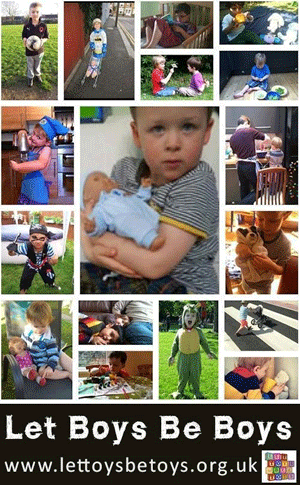
We have found evidence that having access to a wide variety of toys will increase chances of girls studying science and taking up careers in STEM. For example, in one of our most recent blogs by Let Toys Be Toys campaigner and science writer, Laurie Winkless, 18 female scientists were asked what toys they played with as children and we found, without exception, that they were all allowed the freedom to choose to play with and explore a wide variety of toys, free from any sort of labels or being made to feel that they were ‘boys’ toys’.
Similarly, it is important that boys are encouraged to explore imaginative and caring play with dolls, so that more might be incentivised to take up careers in teaching, nursing, childcare and other caring professions. It is essential to offer all children the freedom to explore a wide range of play and toys, so as to widen their career options in the future.
Coming up next for Let Toys Be Toys and how Womanthology readers can help
Although we campaign primarily on Twitter and Facebook, we would like to engage with a wider range of communities, and we are currently exploring new ways to expand our reach beyond social media. We are looking forward to expanding our work with schools, and figuring out innovative ways in which we can get our resources challenging gender stereotypes to more teachers and school staff throughout the country.
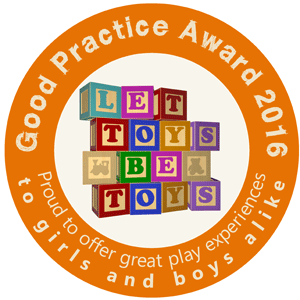
Womanthology readers can find out more information about the campaign at www.lettoysbetoys.org.uk, by liking us on our Facebook page or following us on Twitter at @lettoysbetoys. Our work continues to persuade the remaining few retailers and publishers to drop the gendered signs, and readers can support us by tweeting or sending us any pictures of signs that they may come across. We are always looking to promote more toy and bookshops who are models of good practice, and readers can nominate retailers for a Toymark award via Twitter or by sending us a message at lettoysbetoys@gmail.com.
https://twitter.com/LetToysBeToys
https://www.facebook.com/lettoysbetoys/


